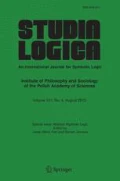Summary
The aim of the paper is to give a new definition of real number. The logical type of any number defined is that of the functionB=h(A) which assigns to a class of setsA a class of sets B. I give some conditions which the functionh has to fulfill to be considered as number; an intuitive sense of the conditions is as follows: a function, which is number, assigns a class of sets of measureh·m to a classA of sets of equal measure, wherem is the measure ofA.
Similar content being viewed by others
References
Bertrand Russell,The principles of mathematics, Cambridge 1903, chapter XXXIII, p. 270, A. N. Whitchead and B. Russell,Principia mathematica vol. 3, Cambridge 1927, *310 *314 (p. 316 ff. p. 336 ff.)
Felix Klein,Elementarmathematik vom höheren Standpunkte aus, Bd. 1. Berlin 1933, p. 35.
David Hilbert,Grundlagen der Geometrie, IV Edition Leipzig-Berlin 1913. Chapter 3 p. 51 ff. Chap. 5, p. 83 ff.
Leon Chwistek,Zasady czystej teorii typów, Przegląd Filozoficzny vol. 25 (1922), p. 361 ff., p. 372 ff. L. Chwistek,The theory of constructive types I. Annales de la Soc. Polon. Math. vol. 2 (1924). R. Carnap,Logische Syntax der Sprache, Wien 1934, p. 76.
See, for example, B. L. van der Waerden,Moderne Algebra vol 1 Berlin 1937, p. 146.
Just as for the fields, for example, B. L. van der Waerden op. cit.Moderne Algebra vol. 1 Berlin 1937, p. 218.
In the manuscript of my dissertation this definition have been replaced by another, less general one: Definition 1.5 A. I say that the class of setsA is positive (in the restricted sense) whenK is not an element of the least ring of sets (in the sense of Hansdrff's) which containsA. In is easy to see that every non-empty positive class in the restricted sense is positive in the sense of the definition 1.5 and that there exist positive classes in the sense of definition 1.5 which are not positive in the restricted sense.
G. Peano,Formulaire mathématique IV, Torino 1903, p. 31, 39.
A. N. Whitehead and B. Russell,Principia mathematica, vol. 2, def. 120.03, p. 203.
The definitions 2.8–2.11 are modified compared with the dissertation according to the modification of the definition 1.5 (see footnote 8).
A. Tarski,O logice matematycznej i metodzie dedukcyjnej, Warszawa p. 159 and the following. English translation:Introduction to logic and to the methodology of deductive sciences, New York 1941.
D. Hilbert and P. Bernays,Grundlagen der Mathematic, vol. 1, p. 320.
A. Tarski,Zur Grundegung der Boole'schen Algebra, Fundamenta Mathematicae, vol. 24 (1935), pp. 176–198.
Additional information
Communicated at the meeting on May 21, 1947
This paper appeared originally under the title “Sur certains groupes formés de classes d'ensambles et leur application aux definitions des nombres” inStudia Societatis Scientiarum Torunensis, Toruń Polonia, Sectio A, vol. I (1948), pp. 23–35.
This paper contains a summary of the dissertation presented to qualify as assistant professor (la disertation de habilitation) to the Faculty of Sciences of the Jagiellonian University in Cracow in 1945. I introduce here some modifications so as to generalize some considerations and I add new section 6.
Rights and permissions
About this article
Cite this article
Jaśkowski, S. About certain groups of classes of sets and their application to the definitions of numbers. Stud Logica 34, 133–144 (1975). https://doi.org/10.1007/BF02123382
Issue Date:
DOI: https://doi.org/10.1007/BF02123382




